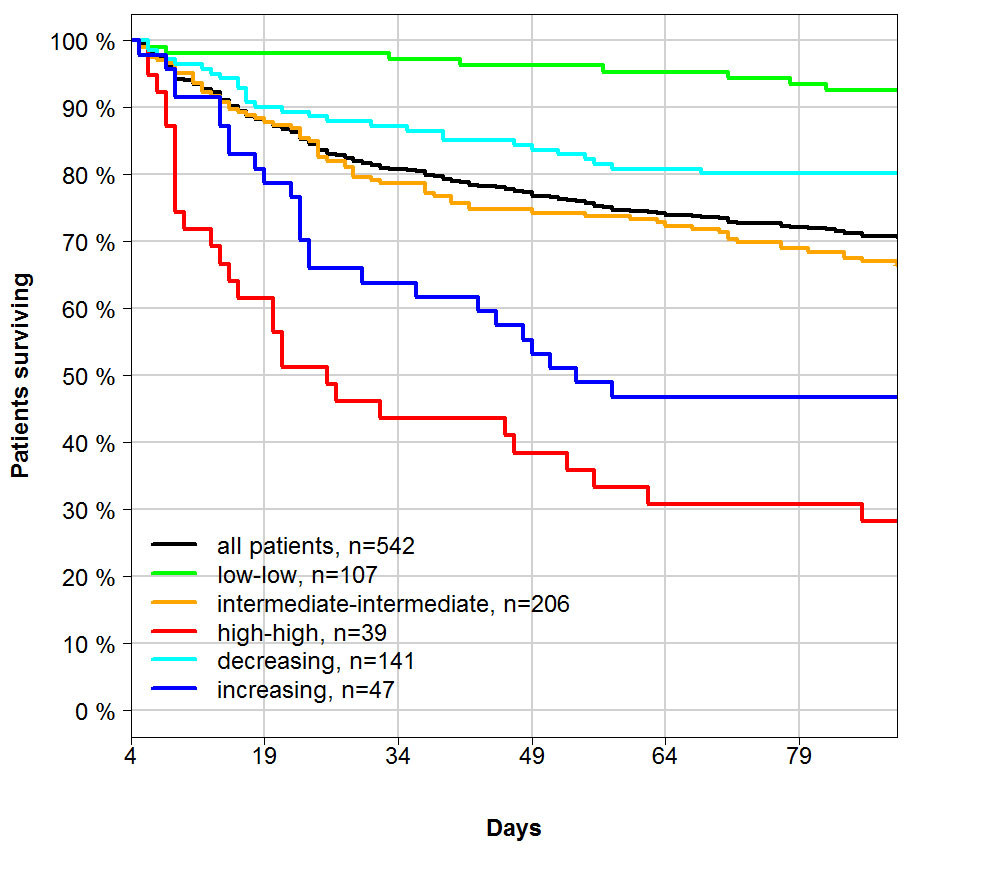Clinical Need: Sepsis Treatment Efficacy Identification
An early indication concerning initial treatment response (i.e. the use of antimicrobials, fluids, vasopressors, supportive organ therapies) is essential in order to adapt and modify treatment at the earliest opportunity possible in patients where treatment is likely to fail.
PCT + MR-proADM to identify initial treatment efficacy
In a publication, the combined use of PCT for guiding antibiotic administration and MR-proADM for assessing the host response was investigated upon sepsis diagnosis and 24 hours after diagnosis. Initial results found that MR-proADM was independent of absolute PCT concentrations at both time points, as well as the delta change in PCT concentrations. Similar findings were also found within the first 4 days of treatment.
Accordingly, patients with decreasing PCT concentrations of ≥ 20% from baseline to day 1 (Panel A) or ≥ 50% from baseline to day 4 (Panel B) were investigated, with corresponding 28 day mortality rates of 18.3% and 17.1%, respectively. This decreased to a 28 day mortality rate of 5.6% and 1.8% when patients had continuously low levels of MR-proADM, and increased to 66.7% and 53.8% in the presence of continuously high concentrations (HR [95% CI]: 19.1 [8.0 - 45.9] and 43.1 [10.1 - 184.0]).
Decreasing PCT concentrations have been shown to indicate the initiation of a successful antimicrobial therapy Ref‑1,2, and the adherence to a PCT guided algorithm shown to facilitate a reduction in antibiotic use Ref‑3‑5. However, the addition of MR-proADM could be shown to provide a significant additional clinical benefit. The early presence of continuously elevated or increasing MR-proADM concentrations – despite decreasing PCT concentrations and on-going intensive care unit (ICU) therapy – may provide a prompt indication as to a likely subsequent failure in treatment and a poor overall outcome. In patients with such a biomarker constellation, therapy should be modified at the earliest opportunity possible. Further studies are required to add additional detail in this field.
PCT + SOFA to identify initial treatment efficacy
A similar model of PCT and SOFA kinetics was subsequently investigated, and found fewer low SOFA severity patents with higher 28 day mortalities between baseline and day 1 (N = 102; 10.8% mortality) or day 4 (N = 64; 4.7% mortality); as well as fewer high severity patients with lower mortality rates between baseline and day 1 (N = 16; 50.0% mortality) or day 4 (N = 31; 41.9% mortality) compared to a combination of PCT and MR-proADM.
In addition, nearly 25% of patients with continuously intermediate SOFA levels showed no significant response (SOFA ± 1 point) to on-going ICU treatment within the first 24 hours after diagnosis. The host response in this patient group is potentially the most difficult to determine when compared to patients with continuously low or high SOFA levels, and therefore an early indication of treatment response is potentially the most clinically useful. This patient group had an overall 28 day mortality rate of 26.2%, yet of these patients, those with continuously low or decreasing MR-proADM concentrations (N = 80; 13.8% mortality) had a significantly lower mortality rate compared to those with continuously high or increasing concentrations (N = 40; 47.5% mortality; HR [95% CI]: 0.1 [0.0 - 0.4]). Similar MR-proADM subgroups could also be found within the stable low, increasing and decreasing SOFA populations.
References Treatment efficacy
Ref-1: Kopterides P, Siempos, II, Tsangaris I, Tsantes A, Armaganidis A. Procalcitonin-guided algorithms of antibiotic therapy in the intensive care unit: a systematic review and meta-analysis of randomized controlled trials. Crit Care Med. 2010;38(11):2229-2241.
Ref-2: de Jong E, van Oers JA, Beishuizen A, et al. Efficacy and safety of procalcitonin guidance in reducing the duration of antibiotic treatment in critically ill patients: a randomised, controlled, open-label trial. Lancet Infect Dis. 2016;16(7):819-827.
Ref-3: Bloos F, Trips E, Nierhaus A, et al. Effect of Sodium Selenite Administration and Procalcitonin-Guided Therapy on Mortality in Patients With Severe Sepsis or Septic Shock: A Randomized Clinical Trial. JAMA Intern Med. 2016;176(9):1266-1276.
Ref-4: Kip MM, Kusters R, MJ IJ, Steuten LM. A PCT algorithm for discontinuation of antibiotic therapy is a cost-effective way to reduce antibiotic exposure in adult intensive care patients with sepsis. J Med Econ. 2015;18(11):944-953.
Ref-5: Wilke MH, Grube RF, Bodmann KF. The use of a standardized PCT-algorithm reduces costs in intensive care in septic patients - a DRG-based simulation model. Eur J Med Res. 2011;16(12):543-548.


